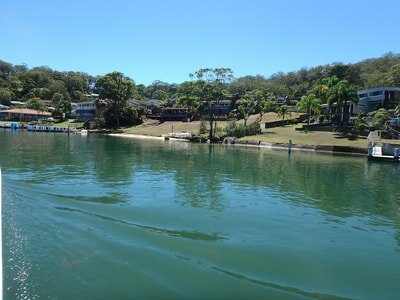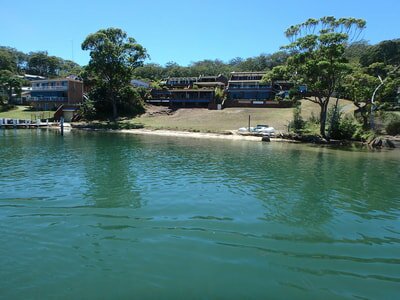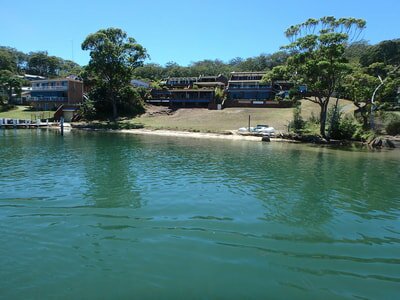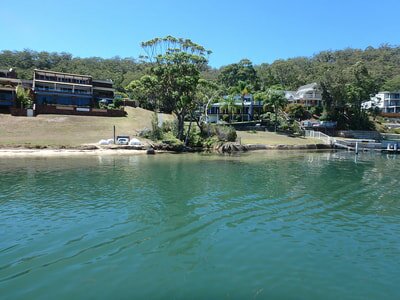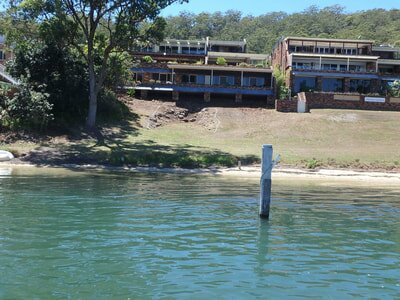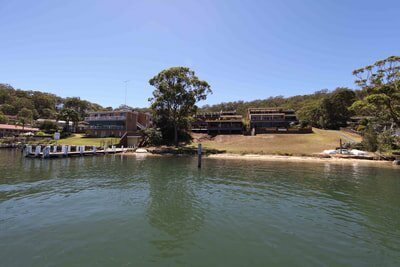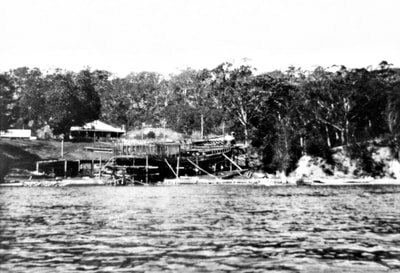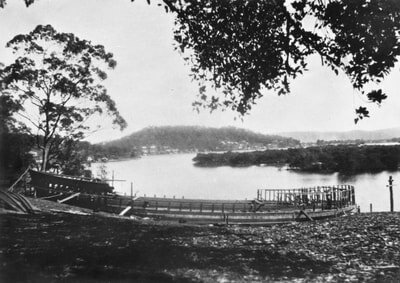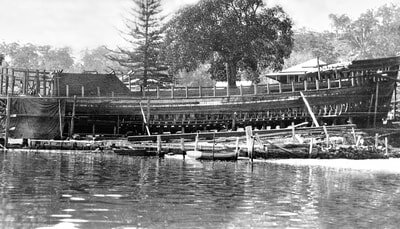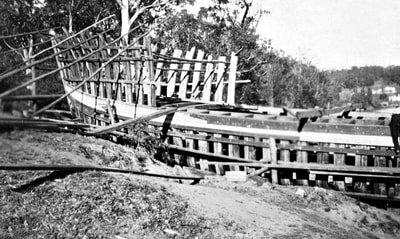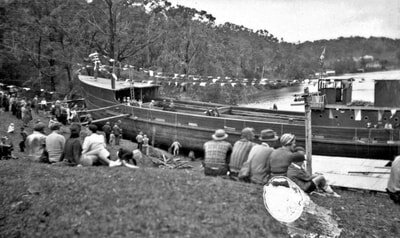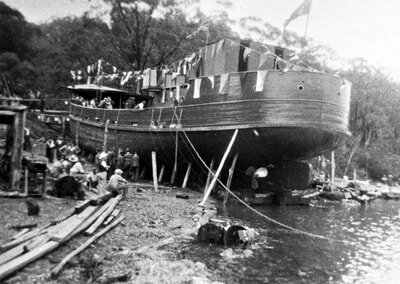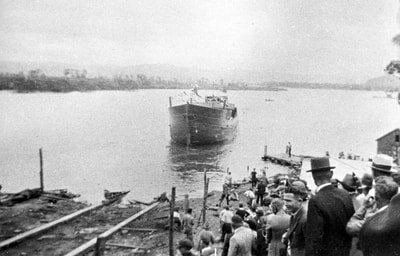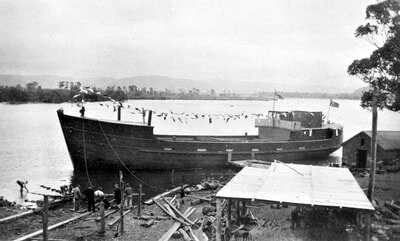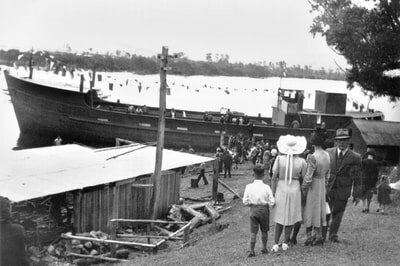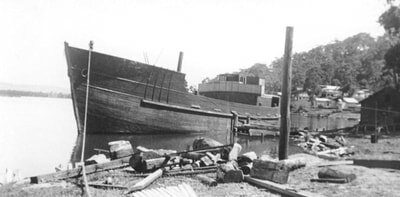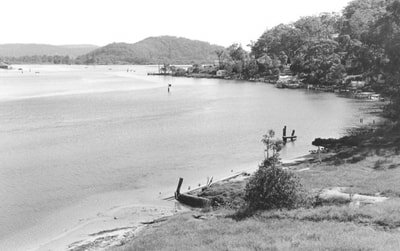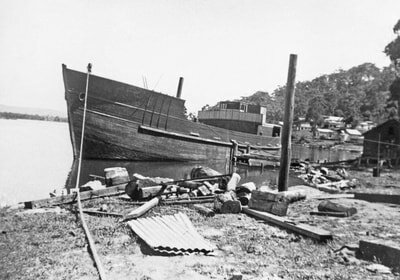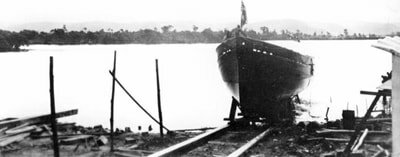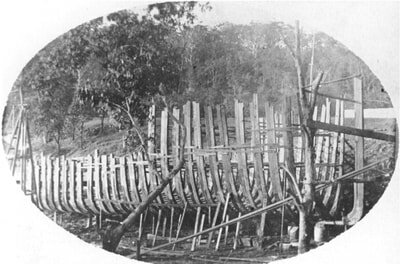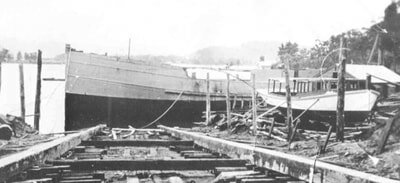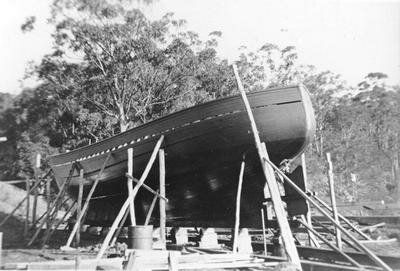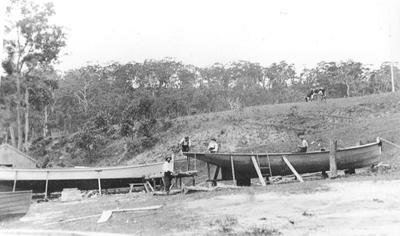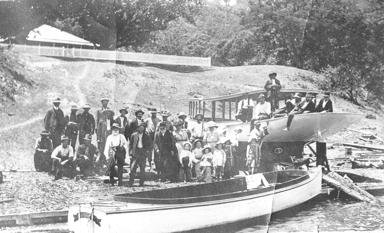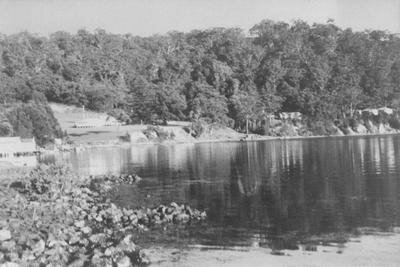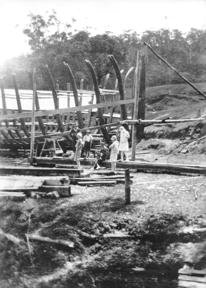Beattie's Yard (Palermo) - Empire Bay - Brisbane Water
The purpose of this page is to assemble images of the yard to facilitate future archaeological evaluation and place upon the historical record an example of the craft and industry that played such a pivotal role in the development and defence of the nation. There is heavy reliance upon images of the Patricia Cam as she was the largest vessel built in the area and many images survive in the collections of Gwen Dundon and the Gosford Historical Society. It was assumed that the Pat Cam had her bow up Cockle Creek to take advantage of the cleft in the bank but eyewitnesses state that she was to the north of the creek and the build up of sand at the mouth creates a shallow area which might hamper a launch. The recovery of finds from the area immediately to the north of the mouth may just reflect a general scatter as no other areas of the site were examined in the brief time available.
The area is Daley's Point - the stretch of water between the site & St Hubert's Island is Cockle Creek - Henry Piper launched his first vessel 'Rainbow' from the site in 1844 - Gwen Dundon 'The Shipbuilders of Brisbane Water' NSW pp84 & 85. The name Palermo Gardens was given to the 1983 housing development & the frontage is Palermo Park - a rare public space and unique surviving site of a shipyard on Brisbane Water. The location is Empire Bay Drive, Daley's Point. The frontage is onto Cockle Creek - the watercourse at the southern end of the site is referred to as the stream which is now piped underground as far as the eastern side of Empire Bay Drive. The Palermo was a private sloop built at the yard in the early 1950's by Gordon Beattie's son Ted. It was registered at Sydney in 1964 as a 30ft transverse wood motor-sailer and was the last vessel built on the site.
The area is Daley's Point - the stretch of water between the site & St Hubert's Island is Cockle Creek - Henry Piper launched his first vessel 'Rainbow' from the site in 1844 - Gwen Dundon 'The Shipbuilders of Brisbane Water' NSW pp84 & 85. The name Palermo Gardens was given to the 1983 housing development & the frontage is Palermo Park - a rare public space and unique surviving site of a shipyard on Brisbane Water. The location is Empire Bay Drive, Daley's Point. The frontage is onto Cockle Creek - the watercourse at the southern end of the site is referred to as the stream which is now piped underground as far as the eastern side of Empire Bay Drive. The Palermo was a private sloop built at the yard in the early 1950's by Gordon Beattie's son Ted. It was registered at Sydney in 1964 as a 30ft transverse wood motor-sailer and was the last vessel built on the site.
Images from the water 2018
Images from the 1970s & 80s
Patricia Cam Build
Other Launches at the Yard
Above left image of Sapphire shows slipway rails run across site diagonally - mouth of stream at left - tender moored in channel as safety boat which was location of Noel Riley on the day of the launch of the Pat Cam in centre image. Image at right shows Pat Cam at jetty with her bow well over the line of the slipway rails - 'the ways'.
It would appear that the Pat Cam was built on the 1920's Doepel & Sapphire slipway – at 389 tons Doepel was a large vessel for this area and the existence of the ways may have influenced Beattie’s selection of the site as the Pat Cam would have been at the extreme end of what was achievable.
The conflict between the recollections of eye-witnesses & the photographs is caused by the slipway being diagonally across the site with the bow at the stream & hard against the side of the hill - whilst the stern is to the north-west across the site and so producing a launch that takes her very close to the jetty where she would be moored. This angle would have made the construction of such a long vessel possible but also it would have meant that the tide was critical in both height and run - if she got out too quickly & into the channel with the tide running and the breeze up then taking up a stern line on the jetty might be a character building exercise.
The conflict between the recollections of eye-witnesses & the photographs is caused by the slipway being diagonally across the site with the bow at the stream & hard against the side of the hill - whilst the stern is to the north-west across the site and so producing a launch that takes her very close to the jetty where she would be moored. This angle would have made the construction of such a long vessel possible but also it would have meant that the tide was critical in both height and run - if she got out too quickly & into the channel with the tide running and the breeze up then taking up a stern line on the jetty might be a character building exercise.
The cut-away in the rock would correspond with the 45ft tugs produced here after the Pat Cam & allow a conventional launch at 90° to the shore.
Preliminary Survey
The finds below are from a brief low-tide survey of the Palermo Park site on 19/1/2018. They have been partially cleaned to preserve some of the black oxide layer that is characteristic of wrought iron. The iron nails would be consistent with an early to mid-19th century timber wharf at the mouth of the creek on the northern side. The shore drops quite sharply here, there’s fresh water, access inland up the stream course, it is sheltered & the land rises steeply behind a small plateau at the water’s edge. It could have been a favoured spot long before shipbuilding. The nails could have been obtained from Sydney & re-used but most likely they were made to order in the local smithy at the time of the build – a greater number & range of objects will enable a good timeline to be set.
The long ‘rose head’ square shanked copper nail is hand-made i.e. the head has been manually hammered and is irregular (not circular) the copper surface is dull and oxidised. The head does not sit flush as does the shorter, more modern nail. Analysis of the composition of the copper will show its constituent percentages and whether they are evenly distributed along the shank – irregularity would indicate cold hammering.
The threaded rod (3rd from Lt) is curious – it appears to be wrought iron and the threaded nut is handmade being very irregular. It may be part of a crude mechanism or tool requiring adjustment but well below the craftsmanship of a clock, instrument maker or gunsmith. The wire nail appears to be machine made from the regularity of the head but the rest is indicative of an older style with crude knurling beneath the head, flattened/hammered areas of the shaft and a point that is chisel shaped and formed by a cold chisel strike.
The heavy blunt wrought iron nails are also hand-made and the squared-off one may be from a wharf or revetment at the mouth of the creek - probably early to mid 19th century so may have been re-used.
The heavy blunt wrought iron nails are also hand-made and the squared-off one may be from a wharf or revetment at the mouth of the creek - probably early to mid 19th century so may have been re-used.
The lump with the nail sticking out was beach rock and contained the oddity that may be the armature of an electric motor. There’s more work to do & a home for them needs to be found in the local district. The first images show the original & treated finds with the iron items in the same relation to eachother. The last image compares 2 Palermo nails on the left with 3 from a secure 1820’s land site.
A Palermo Park Dig would be a valuable archaeological study - yielding interesting finds - examples of the iron fixings used on the Pat Cam should resolve the anomaly of the knee MH7 which is probably Indonesian timber with definitely not Indonesian fixings. The site is unique as all other Brisbane Water shipyard sites have been built over. The opportunity exists to validate & extend Gwen’s historical record, as well as to demonstrate many of the field and maritime archaeological practices. Some geophysics & a shallow NE/SW diagonal trench would reveal the old slipway & other features buried when the site was top-dressed. This would make it attractive to Universities and perhaps a masters or doctoral thesis.
Resources
Ships' Fastenings: From Sewn Boat to Steamship
By Mike McCarthy
Sirius carried “rose head forged copper nails with [tapering] square shanks” also called “convict nails”
By Mike McCarthy
Sirius carried “rose head forged copper nails with [tapering] square shanks” also called “convict nails”


